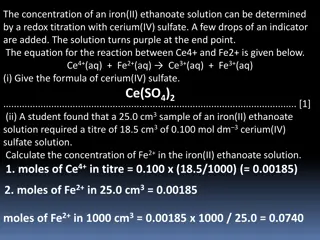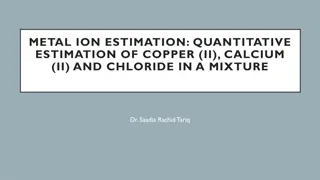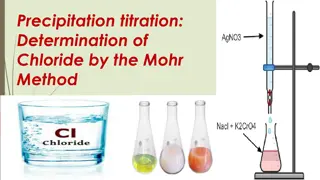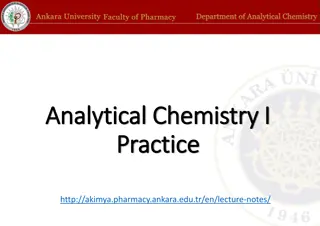Back Titration in Analytical Chemistry
Back titration is a technique used in analytical chemistry to determine the concentration of an analyte by reacting it with an excess of another reagent first, followed by titration of the excess reactant. This method is especially useful in cases where direct titration endpoints are difficult to discern, such as with insoluble salts or slow reactions. The process involves a series of steps including weighing the sample, reacting it with reagents, and calculating the purity of the sample based on the titration results. An example calculation involving ammonium sulfate illustrates how back titration can be applied to determine sample purity and the weight of specific components.
Download Presentation

Please find below an Image/Link to download the presentation.
The content on the website is provided AS IS for your information and personal use only. It may not be sold, licensed, or shared on other websites without obtaining consent from the author.If you encounter any issues during the download, it is possible that the publisher has removed the file from their server.
You are allowed to download the files provided on this website for personal or commercial use, subject to the condition that they are used lawfully. All files are the property of their respective owners.
The content on the website is provided AS IS for your information and personal use only. It may not be sold, licensed, or shared on other websites without obtaining consent from the author.
E N D
Presentation Transcript
Analytical Chemistry lec.8 Prof. . Dr./ Nadia Y. Ahmed Emeritus Prof. of Biochemistry, Fac. of Agric. Benha Univ. Dr/ Nesreen S. Salim
BACK TITRATION Basically, you use a back titration when you need to determine the strength or concentration of an analyte and you have a known molar concentration of excess reactant. It's typically applied in acid-base titrations when the acid or (more commonly) base is an insoluble salt (e.g., calcium carbonate),
when direct titration endpoint would be hard to discern (e.g., weak acid and weak base titration), or when the reaction occurs very slowly. Back titrations are applied, more generally, when the endpoint is easier to see than with a normal titration, which applies to some precipitation reactions.
Determine of ammonium salt purity Weight accurately the sample(1 g of ammonium sulfate) and place in volumetric flask then use2 .25 ml of NaOH in a pipette for the titrations and boiling. After boiling, titrate the excess of NaOH by HCl solution known concentration . So Equivalent number of ammonium sulfate = Equivalent number of NaOH - number of HCl Equivalent
FOR EXAMPLE : - A non-pure sample of ammonium sulfate weighed 0.7 grams, was treated with a volume of 100 ml of 0.15 N NaOH, and after heating it was needed to 50 ml of 0.1 N of acetic acid to neutralize the solution. Calculate the purity of the sample and the weight of the ammonia in the sample. - Solution : Eq. n. of (NH4)2SO4 = Eq n. of NaOH - Mass/ E.W. = (V*C)- (V*C) Mass/ 66 = ( (100/1000)*0.15) ((50/1000)*0.1) So Mass = 0.66 gram the purity = ( pure mass / total mass) 100 = (0.66/0.7 ) 100 = 94.28 % Eq. n. of CH3COOH - - - - - - -
WEIGHT OF THE AMMONIA IN THE SAMPLE: 1 mol of ammonium sulfate having 2 mole of ammonia according to the following equation: (NH4)2SO4 2 NH4 Weight =( M.W. of 2 NH4 pure mass) / M.W of (NH4)2 SO4 = ( 40 0.66 ) / 132 = 0.2 g
AND NOW TRY THIS: A mixture containing 0.1 mol of both ammonium chloride and ammonium phosphate. Calculate the weight of sodium hydroxide needed to remove ammonia from the mixture. And what is the weight of the nitrogen produced from the mixture?
SOME EXAMPLES 1- 50 ml of silver nitrate solution 0.21 N was added to 0.5 g SrCl2. After separation of the ppt with AgCl . 25.5 ml of KCNS 0.28 N was needed to equilibrium. What is the ratio of SrCl2 in the sample. Solution: E.N. of AgNO3 = E.N. of SrCl2 + E.N. of KCNS V N = (MASS /E.W) + V N (50/1000) 0.21 = (MASS/ (78.81 2)) + (25.5/1000 ) 0.28 MASS = 0.265 g % of SrCl2 =( 0.265/0.5 ) 100 = 53 %.
2- An indigestion was curshed up a tablet and an excess hydrochloric acid (25.0 cm3 of 1.00 mol dm-3). The resulting solution was titrated against 0.500 mol dm-3 NaOH requiring 25.8 cm3 of the NaOH. Calculate the mass of calcium carbonate in the tablet. solution: Mole of NaOH =molar concentratin / volum per liter = (0.500 25.8)/1000 = 0.0129 HCl + NaOH NaCl +H2O So Moles of HCl = 0.0129 Mole of HCl intially = (25.0 1.00)/1000 =0.025 Mole of HCl used = 0.025 - 0.0129 = 0.0121 CaCO3 + 2HCl CaCl2 + CO2 + H2O SO :mols of CaCO3 = 0.0121 / 2 = 6.05 10-3 Mass of CaCO3 = mols / molecular weight = 6.05 10-3 / 100 =0.606 gram
3- A fertiiliser contains ammonium sulphate and potassium sulphate. A sample of 1.455 g og the fertiliser was warmed with 25.0 cm3 0.200 mol dm-3 sodium hydroxide solution giving off ammonia gas. The remaining NaOH that was not used required 28.7 cm3 of 0.100 mol dm-3 hydrochloric acid for neutralisation. Calculate the percentage by mass of ammonium sulphate in the sample. Solution : Moles of HCl =( 28.7 0.100 )/1000 = 2.78 10-3 HCl + NaOH NaCl +H2O So:Moles of NaOH = 2.78 10-3 Moles of NaOH =( 25.0 0.200 )/1000 =0.005 Moles of NaOH = 0.005 - 2.78 10-3 = 0.000213 NH4+ + OH- NH3+ H2O Moles of NH4+= moles of OH = 0.000213 Moles of( NH4)2 SO4 = 1.065 10-3 Mass = 0.141 g Percentage = ( 0.141 / 1.455) 100 = 9.69 %
4- 150.0 ml of 0.2105 M nitric acid was added excess to 1.3415 g calcium carbonate .The excess acid was back titrated with 0.1055 M sodium hydroxid. It required 75.5 ml of the base to reach the endpoint . Calculate the percentage (w/w) of calsium carbonate in the sample. A) Extraction information : HNO3 V= 150.0 ml ,M= 0.2105 M CaCO3 mass = 1.3145 g NaOH V = 75.5 ml , M= 0.1055 M B) write the balanced equation : 2HNO3+ CaCO3 Ca(NO3)2+ CO2+ H2O (1) HNO3+ NaOH NaNO3+ H2O (2) 2 mole of HNO3react with 1 mole of CaCO3 1 mole of HNO3 react with 1 mole of NaOH C)- Calculate no. of mole Intial amount of HNO3 : No. of mole of acid = 0.2105 150 = 31.575 mole acid. excess acid No. of mole of excess acid = 0.1055 75.5 = 7.965 mmole acid
mole of acid reacted with CaCO3 = (31.575 7.965) = 23.61 mole acid D) mole ratio 2 mole of HNO3 react with 1 mole of CaCO3 Thus , 23.61 mole ofHNO3react with (23.61) mole of CaCO3 mole of CaCO3 = mole acid = 32.61 = 11.805 mole CaCO3 E) Find mass Gram CaCO3= mole molar mass = 11.805 10-3 100 = 1.1805 g F) Find percentage % CaCO3 = weight of sample 100 = (1.1805/1.3415) 100 = 87.99 %
NOW TRY THIS A 0.500 g sample containing Na2CO3 is analyzed by adding 50.0 ml of 0.100 M HCl , a slight excess , boiling to remove CO2 , and then back-titration the excess acid with 0.100 M NaOH . I f 5.6 ml NaOH is required for the back titration , what is the percent Na2CO3 in the sample ? Molar mass for Na2CO3 = 106 Answer (47.1%)

 undefined
undefined
































